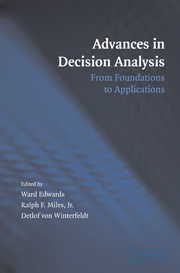Book contents
- Frontmatter
- Contents
- List of Contributors
- Preface
- 1 Introduction
- PART I HISTORY AND FOUNDATIONS OF DECISION ANALYSIS
- PART II STRUCTURING DECISION PROBLEMS
- PART III PROBABILITIES AND BAYES NETS
- PART IV UTILITIES
- 12 Utility and Risk Preferences
- 13 Practical Value Models
- 14 Extensions of the Subjective Expected Utility Model
- PART V RISK ANALYSIS
- PART VI DECISION ANALYSIS IN A BEHAVIORAL AND ORGANIZATIONAL CONTEXT
- PART VII APPLICATIONS OF DECISION ANALYSIS
- Index
- References
12 - Utility and Risk Preferences
Published online by Cambridge University Press: 05 June 2012
- Frontmatter
- Contents
- List of Contributors
- Preface
- 1 Introduction
- PART I HISTORY AND FOUNDATIONS OF DECISION ANALYSIS
- PART II STRUCTURING DECISION PROBLEMS
- PART III PROBABILITIES AND BAYES NETS
- PART IV UTILITIES
- 12 Utility and Risk Preferences
- 13 Practical Value Models
- 14 Extensions of the Subjective Expected Utility Model
- PART V RISK ANALYSIS
- PART VI DECISION ANALYSIS IN A BEHAVIORAL AND ORGANIZATIONAL CONTEXT
- PART VII APPLICATIONS OF DECISION ANALYSIS
- Index
- References
Summary
ABSTRACT. Utility theory has been a primary method used for the analysis of decision making under uncertainty for the last 60 years. We describe the rationale and uses of the approach in the case of decisions involving money. Our focus is the question of which particular utility function should be used by a decision maker.
Introduction
Playing games of chance for money is an activity that has diverted people for at least 6 millennia, so it is reasonable to suppose that an interest in how one should think about maximizing wealth under uncertainty has existed at least as long.
The starting point for all students of decision analysis is Expected Monetary Value (EMV) (Raiffa 1968). If there are i possible courses of action under consideration, and n possible outcomes x1, …, xn, and if pij is the probability that action i leads to monetary outcome xj, then EMV suggests that one select the action i that maximizes ∑j pij xj. The justification for this criterion – and it's a good one – is that any other criterion, if used repeatedly, will assuredly (almost certainly) leave you less well off at the end. Though few people get to repeat the same gamble over and over again, EMV is still relevant in our lives because we often make decisions involving financial uncertainty, and using EMV to make them will almost certainly be the right criterion for choice.
- Type
- Chapter
- Information
- Advances in Decision AnalysisFrom Foundations to Applications, pp. 221 - 231Publisher: Cambridge University PressPrint publication year: 2007
References
- 1
- Cited by



